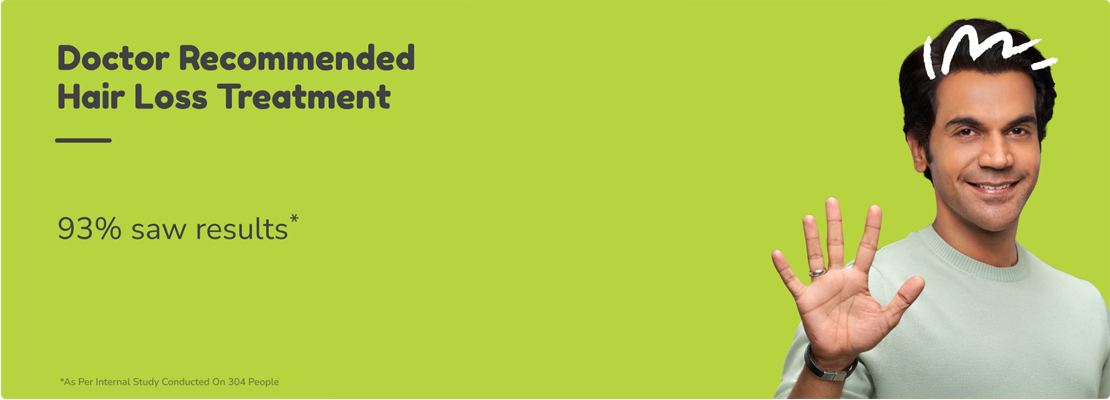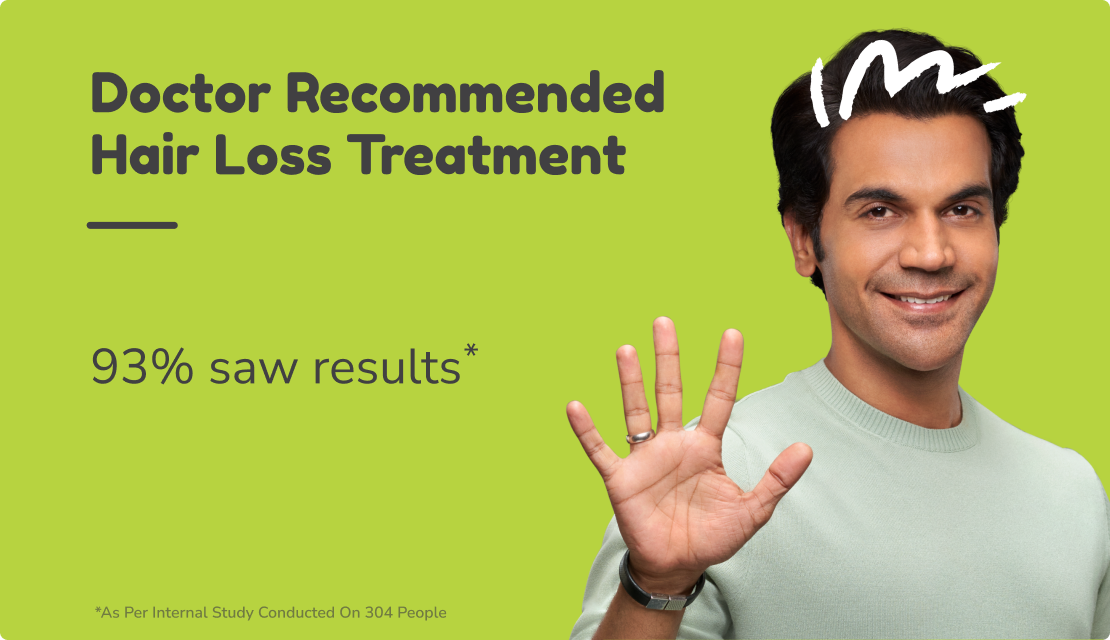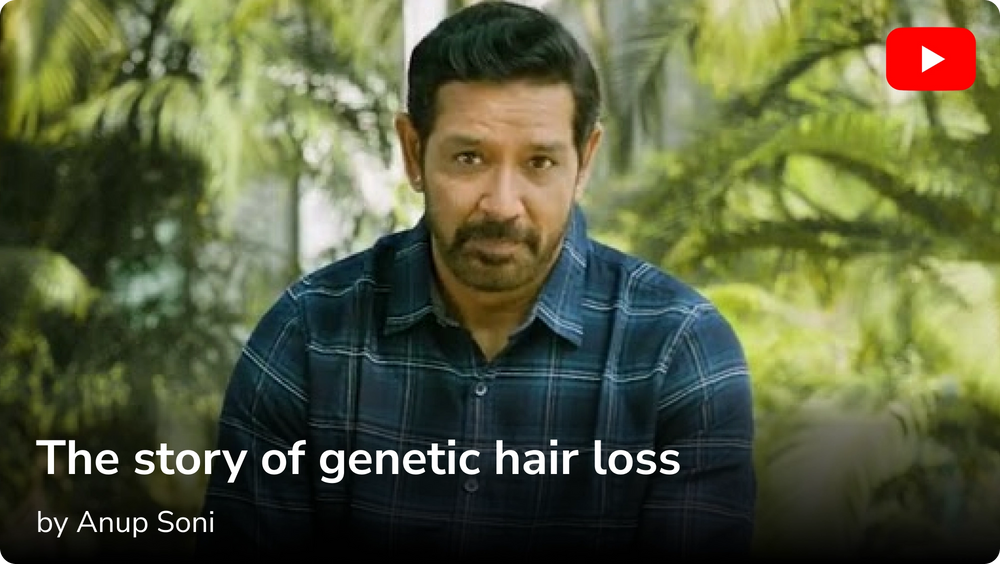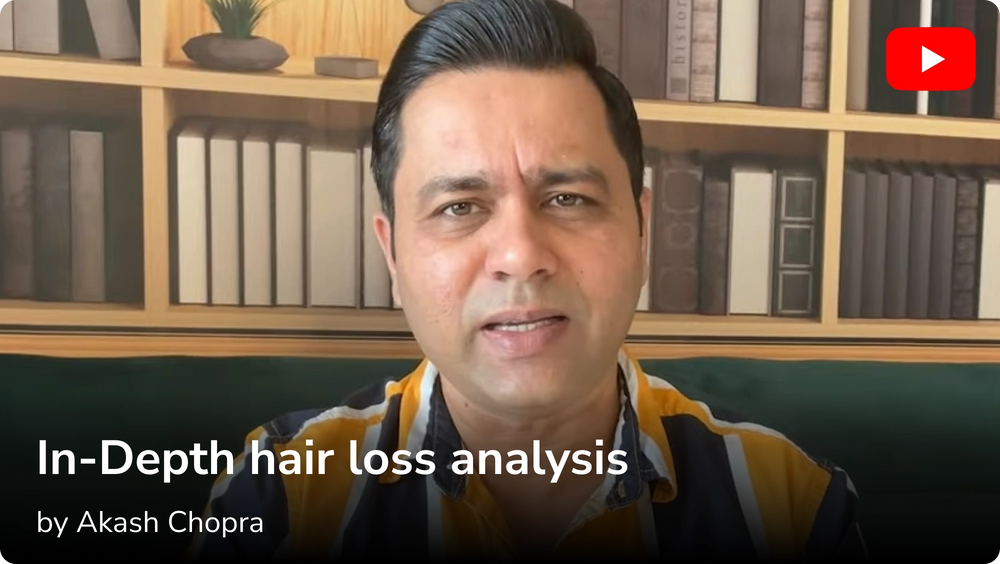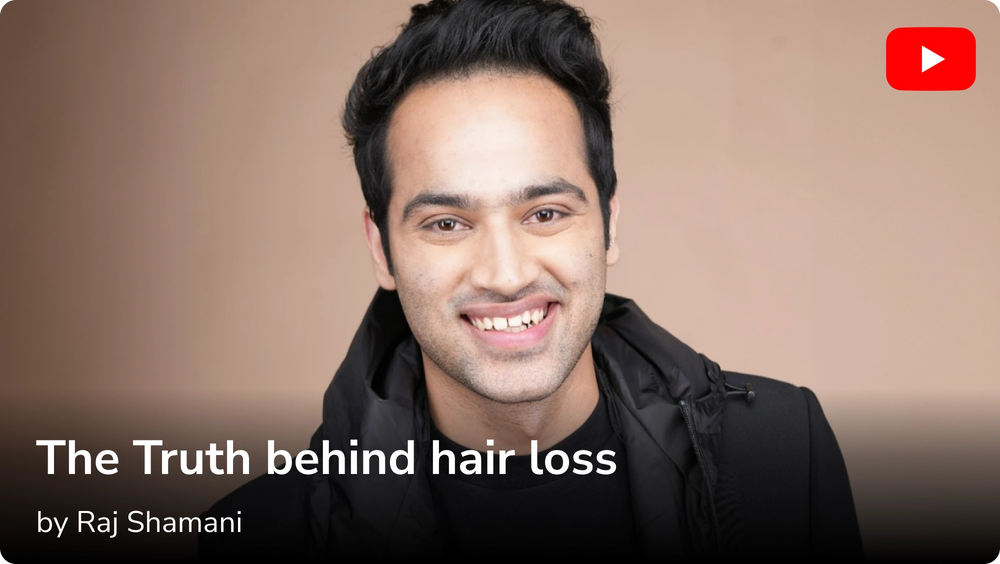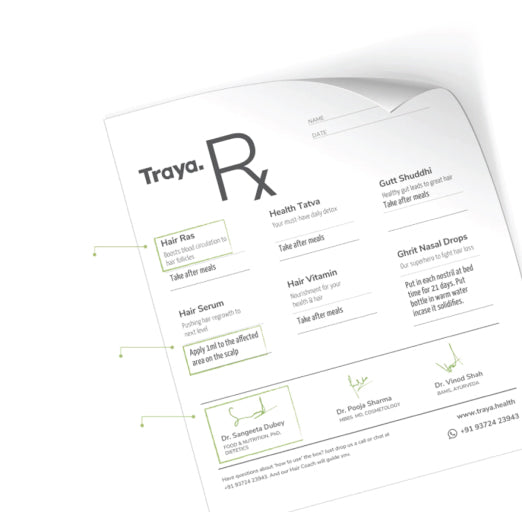Have you tried every available shampoo and hair care product, but your hair still shows no signs of regrowth? If so, you’ve come to the right place to learn about natural ways to care for your hair through Ayurveda! At Traya, we’ve found that around 80% of our customers see remarkable improvements in hair health when we focus on resolving their gut and gastric issues using Ayurvedic practices.
Ayurveda acts like a wise friend who gets to the root of the problem and solves it from within. It helps restore internal balance in your body, enhancing overall health. According to Ayurvedic principles, hair loss is often linked to high levels of pitta in the body, which affects follicle health and overall hair quality.
In a world full of chemical products and harsh treatments, let’s explore the incredible benefits of Ayurvedic Hair Loss Treatment and how it can naturally transform your hair. And if you're unsure where to start, take our Free Hair Test today. This quick and easy test will help you understand the root cause of your hair loss and guide you towards a personalized Ayurvedic treatment plan.
Ayurvedic Science behind Hair fall
Ayurveda believes that your body comprises three types of life forces - kapha, vata, and pitta; elements like fire, water, space, air, land, and ether characterise each. Fire or Agni dominates Pitta and is responsible for your appetite, digestion and nutrition absorption. However, when in excess, unchecked Pitta dosha can result in premature greying, causing hair thinning and hair loss.
Understanding the impact of doshas on hair health:
- Vata Dosha Effects: Imbalances in Vata dosha can result in dryness, frizziness, split ends, hair thinning, and hair loss.
- Pitta Dosha Effects: Elevated Pitta levels can lead to overheating hair follicles, ultimately causing hair fall. This imbalance may also contribute to premature hair greying, hair thinning, and baldness.
- Kapha Dosha Effects: Excessive Kapha can result in sticky and highly oily hair, leading to wet and sticky flakes. This makes the hair exceptionally heavy, greasy, and challenging to manage.
In Ayurveda, recognising the interconnectedness of the nervous system and digestive health with hair health is crucial. By addressing the root cause of imbalances in doshas, Ayurvedic practices aim to promote overall well-being and vitality.
Ayurvedic Approach to Hair Loss
We often believe that external treatments, such as oiling, shampooing, or massaging your scalp, are the only ways to promote thick, long, and beautiful hair. However, that is only part of it. Just as external care is crucial, prioritising internal well-being is equally imperative. Why? Because Hair fall is a symptom of an underlying issue.
Hair fall can be caused by multiple reasons, including but not limited to stress, sleep issues, weight and dieting, poor gut health, hormonal imbalances, genetics, etc. In a study conducted by Traya, we found that 37% of men in this study attributed their hair loss to poor gut health.
You might be wondering, "Isn't stress, anxiety, and sleep deprivation just a part of daily life for everyone? How can we address our mental well-being in such a demanding lifestyle?" Well, this is where Ayurveda shines. It goes beyond providing short-term solutions and focuses on enhancing overall well-being. Ayurveda acknowledges the connection between mental and physical health, offering the best approaches that benefit your hair and contribute to your overall well-being. Embracing Ayurveda means treating the symptoms externally and nurturing your body and mind from within.
In the world of Ayurveda, the concept of customised remedies for hair loss is diverse, emphasising a personalised approach tailored to individual patterns and types of hair loss. Rather than adopting a one-size-fits-all solution, Ayurvedic practitioners thoroughly assess factors like dosha constitution, lifestyle, and overall health. This in-depth understanding enables the formulation of remedies that address the unique characteristics of each person's hair, such as texture, thickness, and specific hair loss patterns.
This personalised approach extends beyond surface-level symptoms, aiming to tackle the root causes of hair loss. Ayurvedic treatments include external applications like herbal formulations and oils and dietary recommendations designed to nourish the scalp and strengthen hair follicles.
Effective Ayurvedic Ingredients for Hair Loss Treatment
Here are some ayurvedic treatments for hair loss and regrowth that anybody can use without fearing the side effects:
Bhringraj (Eclipta alba)
Bhringraj is one of the best herbal remedies for hair care and boasts antibacterial, anti-inflammatory, and anti-allergic properties. Recognised for promoting hair growth, preventing hair fall, and slowing down greying, it addresses issues like dandruff and dry scalp. Beyond hair benefits, Bhringraj is a multipurpose gem for hair health and overall well-being. Bhringraj helps widen the blood vessels, which helps in better blood flow to the roots, promoting hair growth.
Amla (Indian Gooseberry)
Amla is rich in Vitamin C. Hence, it elevates antioxidants in the body, purifying the blood and preventing premature greying for vibrant natural hair colour. Its antifungal and antiviral properties combat dandruff, enhance scalp health, and prevent fungal infections. Amla penetrates follicles with essential fatty acids, resulting in softer, shinier, and voluminous hair. Moreover, its high iron and carotene content stimulates hair growth, making it a holistic powerhouse for hair health.
Shikakai
It is a precious Ayurvedic herb, an effective remedy for hair-related issues, particularly hair fall. Its Kashaya property makes it adept at removing dirt and excess oil from the scalp, contributing to a healthier scalp environment. Beyond cleansing, Shikakai is recognised for promoting hair growth, adding to its allure as a trusted Ayurvedic solution for preventing hair loss.
Coconut
Coconut oil is a versatile ally for hair care, moisturising and repairing damaged strands. Its effectiveness extends to dandruff prevention, making it a beneficial addition to your hair care routine. Coconut oil caters to various needs, Whether prewash treatment, conditioner, hair mask, or styling aid. Start with a small amount to gauge your skin's reaction. Additionally, the antibacterial properties of coconut oil are advantageous for the scalp, and periodic application in the form of a hair mask can stimulate hair growth, prevent breakage, and enhance moisture retention.
Brahmi (Bacopa monnieri)
Brahmi can be a solution for temporary baldness, promoting hair growth in areas where thinning has occurred. Its efficacy extends to reducing hair loss by addressing dandruff and inflammation, offering a calming and soothing experience with regular use. To harness Brahmi's benefits for hair growth, warm the oil and gently massage it into your scalp, enhancing blood circulation. Leave it on for at least 30 minutes or overnight, then rinse with a mild shampoo for a revitalised and nourished mane.
Reetha
With its rich iron content, Reetha helps promote hair growth and prevent loss. This natural ingredient strengthens hair follicles, fostering healthy development. Widely incorporated into shampoos, reetha's dried fruit powder is a foaming agent, effectively cleaning oily secretions from the skin and acting as a natural hair cleanser and tonic. Moreover, it's known for its lice-removing properties. However, it's crucial to exercise caution and refrain from self-medication. Consulting with a doctor is always the best practice, and any herbal usage should be done under professional recommendation.
Methi seeds
Methi seeds are also known as Fenugreek. They are a powerhouse of vitamins and folic acid, making them excellent hair growth promoters. Packed with nicotinic acid, these seeds effectively combat hair fall issues. Widely regarded as beneficial Ayurvedic herbs for hair growth, methi seeds nourish the scalp, accelerating the growth of strong and healthy hair. An easy method involves mixing methi seeds with coconut oil and applying the blend to the scalp, providing a natural boost for hair strength and vitality.
Beyond mere cleansing, herbal remedies are vital in enhancing overall hair health. Warm herbal oils applied before a hair bath and herbs into scalp and hair masks, cold or warm rinses, and hair teas or soaks can be beneficial.
Read this blog to learn more about Home Remedies for Hair Fall.
Ayurvedic Therapy for Hair Growth: Ayurvedic Hair Fall Remedies
Shirodhara
Shirodhara is one of the most effective therapies for hair fall. The term Shirodhara means - flow in the head. Here, warm oils formulated with Ayurvedic herbs are poured on the forehead from a container above a particular height. The oils travel from your forehead to the scalp and are gently massaged by the therapist.
Shirodhara works at multiple levels as a potent ayurvedic treatment for hair fall. It extracts dead skin cells from the scalp and improves the nervous system's functioning. It increases the blood circulation in the scalp, leading to better and healthier hair growth. It removes the toxins from the body and relieves stress. This therapy balances the Pitta and Vata doshas in your body.
Shiro Lepa
Shiro Lepa involves using Ayurvedic herbs in a powder form and making a paste with it. The paste is then applied to the scalp and covered with a banana leaf. The top part of the scalp is left open. Medicated Ayurvedic oils are poured on the part of the scalp left open and covered with the leap, a highly potent Ayurvedic treatment for hair fall. This enhances the interaction of the lepa with the scalp tissues, promoting healthier hair growth. It normalises frizzy hair and repairs split ends.
Shiro Lepa is beneficial in pacifying the Pitta dosha. It is also helpful in balancing the nervous system and produces a calming effect on various body organs, which also helps promote hair health.
Shiro Abhyanga
This therapy involves massaging the shoulders, upper back, neck, and head with warm oils like coconut and sesame. This prevents the scalp from heating up and nourishes the hair follicles and sensory organs. This uses ayurvedic medicine to reduce hair fall and dandruff. It helps relieve stress by relaxing your upper body and muscles.
As per the Yogic Science, maintaining a balance between the three upper chakras - Vishuddha (throat), Sahasrara (top of head), and Anja (forehead) - is essential, and this therapy does that. Take advantage of this unique ayurvedic hair loss treatment.
Ayurvedic Hair Treatment for Hair Loss: Ayurveda Baldness Treatment
Ayurveda, a holistic practice with a rich historical background, is recognised for its efficacy in addressing various health conditions, including bald patches. Ayurvedic experts emphasise its holistic approach to hair growth. Noteworthy herbs employed in inhibiting DHT production, a contributor to hair loss, include green tea, saw palmetto, pumpkin seed, and the traditional herb Giant Dodder, known for its anti-androgen properties in Ayurveda.
Scientific studies support the effectiveness of Bhringraj oil in promoting hair regrowth. This oil inhibits TGF-β1 expression, stimulating healthy hair follicles. Bhringraj oil application is beneficial for treating alopecia, a condition leading to hair fall and bald patches. Additionally, Bhringraj oil is known to have a cooling effect on the head, helping reduce stress and nervousness. The herb's rich mineral and vitamin content also aids in minimising hair breakage and preventing hair loss.
Ayurvedic Hair Growth Serum
Creating an Ayurvedic hair growth serum will help you in your hair growth journey, and you can do that by combining natural ingredients known for hair-nourishing properties. Here's a simple recipe and guide on how to use it:
Ingredients:
- Bhringraj oil: 2 tablespoons
- Amla oil: 1 tablespoon
- Coconut oil: 1 tablespoon
- Castor oil: 1 tablespoon
- Essential oil (like lavender or rosemary): 5-10 drops (optional)
Instructions:
- Mix Bhringraj, Amla, coconut, and castor oil in a bowl.
- Optionally, add a few drops of essential oil for fragrance and additional benefits.
- Stir the mixture well to ensure even distribution of the oils.
How to Use:
- Section your hair for easier application.
- Using your fingertips or a cotton ball, apply the serum to your scalp and gently massage in circular motions. Ensure even coverage.
- Continue massaging for 5-10 minutes to stimulate blood circulation.
- Once applied to the scalp, distribute the remaining serum along the length of your hair.
- Leave the serum on for at least 30 minutes or, for better results, leave it overnight.
- Wash your hair with a mild, herbal shampoo to remove the oil. Apply this Ayurvedic hair growth serum 1-2 times weekly for optimal results.
Traya and Ayurvedic Solution for Hair Fall
At Traya, we understand the crucial role of internal health for hair and the benefits Ayurveda provides for hair loss treatment. This is why Ayurveda is one of the 3 Sciences that form the foundation of our holistic treatment. We work on your internal issues and solve them from the root. Here are a few causes of hair fall and our Ayurvedic Supplements, created to target these specific issues:
|
CAUSES OF HAIR FALL |
TRAYA’S AYURVEDIC SUPPLEMENTS |
|
Gut Imbalances |
Gut Shuddhi, Consti Clear |
|
Sleep Issues / Stress |
Nasal Drops, Scalp Oil with Calm Therapy Booster |
|
Low Energy/ Metabolism |
Health Tatva, Cholest Vati |
|
Hormonal Imbalances |
Thryo Santulan, PCOS Santulan, Mom Santulan, Meno Santulan |
|
Nutritional Deficiencies |
Hair Vitamin |
Ayurveda is preventive, which means it will prevent hair loss. But since most people only turn to Ayurveda after they lose hair, they have to take the help of a holistic approach that includes Allopathy and Nutrition. Traya does just that! By understanding the root cause of your hair loss via our free hair test, Traya provides a personalised, holistic kit that addresses all your hair fall problems.
Take Traya’s free hair test to understand your root cause, and unlock your hair treatment kit to get results. See for yourself how Traya has transformed the lives of people by solving their hair fall problems:
Key Takeaways:
Ayurvedic hair loss and regrowth treatment offers a natural, effective solution for those seeking an alternative to chemical treatments. Embracing this ancient wisdom and practices this ancient wisdom and practice can lead to healthier, fuller hair, proving Ayurveda's time-tested effectiveness in hair care.

Ayurveda offers a wealth of natural remedies and treatments to combat hair fall and promote hair regrowth. From herbal oils like amla and Brahmi to stress-reducing herbs like ashwagandha, each remedy targets specific hair ailments and nourishes the scalp, leading to healthier hair growth. Additionally, Ayurveda emphasises the importance of a balanced lifestyle and diet to support overall well-being, making it a gentle and effective alternative to chemical-laden hair products and treatments.
By acknowledging the diversity of individuals and tailoring remedies to their distinct needs, Ayurveda offers an effective solution for managing and preventing hair loss, promoting overall well-being in the process. It's a blend of ancient wisdom and individualised care that resonates with the uniqueness of each person.










